While it's amazing how much of Ancient Rome survives above ground, there's even more hidden beneath.
Silting from Tiber floods and the practice of building medeival, Renaissance, and later structures atop the crumbling remains of Roman-era buildings has left much of the ancient city buried underneath the streets and architecture of Rome. And there's more being discovered and excavated all the time, including in 2012 the remains of an art center from Hadrian's era (scheduled to open to the public soon).
Much of this is simply in the basements of private buildings, but some is open to the public. Here are some personal favorites.
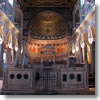 San Clemente ★★ - This early medieval church's mosaics, marbles, and Masolino frescoes would be worth a visit in of themselves. But the real show here is that you can head downstairs to see Rome's layer effect at work, exploring church layered upon church layered upon pagan temple to Mithras and ancient Roman streets and houses... » more
San Clemente ★★ - This early medieval church's mosaics, marbles, and Masolino frescoes would be worth a visit in of themselves. But the real show here is that you can head downstairs to see Rome's layer effect at work, exploring church layered upon church layered upon pagan temple to Mithras and ancient Roman streets and houses... » more Colosseum dungeons and upper tiers ★★★ - Opened for the first time in 2012—but only to small groups with a licesed guide—the ipogei "dungeons" below the floor of the Colosseum are where gladiators and wild beasts once waited for their turns at the spectacle above—you can even see the elevators and lift platforms that were used to hoist them up to the arena floor...
... » more
Colosseum dungeons and upper tiers ★★★ - Opened for the first time in 2012—but only to small groups with a licesed guide—the ipogei "dungeons" below the floor of the Colosseum are where gladiators and wild beasts once waited for their turns at the spectacle above—you can even see the elevators and lift platforms that were used to hoist them up to the arena floor...
... » more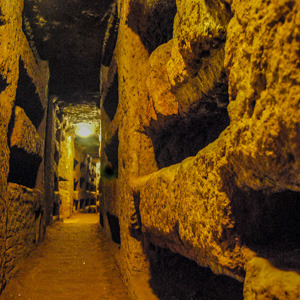 The Catacombs ★★ - These miles of low, dimly lit tunnels carved into the soft tufa honeycomb the earth beneath the Via Appia Antica are wildly popular among tourists. The catacomb tunnels are pigeonholed with tens of thousands of niches where early Christians buried their dead and left some of the world's first Christian art.... » more
The Catacombs ★★ - These miles of low, dimly lit tunnels carved into the soft tufa honeycomb the earth beneath the Via Appia Antica are wildly popular among tourists. The catacomb tunnels are pigeonholed with tens of thousands of niches where early Christians buried their dead and left some of the world's first Christian art.... » more Santa Cecilia in Trastevere ★ - You'd never know from the bland baroque interior that there are the remains of a Roman house under this church, or that you can slip a modest bribe to the nuns to get inside the cloistered section to see one of Rome's last remaining medieval masterpieces of fresco by Pietro Cavallini... » more
Santa Cecilia in Trastevere ★ - You'd never know from the bland baroque interior that there are the remains of a Roman house under this church, or that you can slip a modest bribe to the nuns to get inside the cloistered section to see one of Rome's last remaining medieval masterpieces of fresco by Pietro Cavallini... » more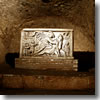 Mithraeum of the Circus Maximus - Discovered during construction of a Fascist-era building. Alos down here are the remains of several Roman temples.... » more
Mithraeum of the Circus Maximus - Discovered during construction of a Fascist-era building. Alos down here are the remains of several Roman temples.... » more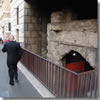 Stadium of Domitian under Piazza Navona - The odd, oblong shape of this famous, café-lined piazza splashing with Bernini fountains is due to the fact that it was built atop the ancient Stadium of Domitian. The basements of many of its Renaissance and baroque palazzi preserve ancient remains, but the only bit visible to or accessible to the public are some travertine arches under a bank building at the north end of the square (exit the piazza to the busy road beyond, turn left, walk a few feet, and peer down through the fence on your left)... » more
Stadium of Domitian under Piazza Navona - The odd, oblong shape of this famous, café-lined piazza splashing with Bernini fountains is due to the fact that it was built atop the ancient Stadium of Domitian. The basements of many of its Renaissance and baroque palazzi preserve ancient remains, but the only bit visible to or accessible to the public are some travertine arches under a bank building at the north end of the square (exit the piazza to the busy road beyond, turn left, walk a few feet, and peer down through the fence on your left)... » more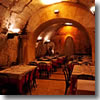 Teatro di Pompeo - The remains of an ancient Roman amphitheater in the basement of a contemporary Roman restaurant (killer pasta all'amatriciana, too).... » more
Teatro di Pompeo - The remains of an ancient Roman amphitheater in the basement of a contemporary Roman restaurant (killer pasta all'amatriciana, too).... » more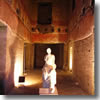 Domus Aurea (Nero's Golden Palace) ★ - After the Great Fire of AD 64, Nero seized more than 200 acres of the city's burned-out historic core to create one of the most sumptuous palaces in history, slathered in frescoes and stuccoes, with rotating banquet tables over which would drift showers of flower petals, and entire rooms laminated in gold leaf (hence the nickname). It was a party palace par excellence for an emperor who would go down in history as one of the most hated leaders of all time... » more
Domus Aurea (Nero's Golden Palace) ★ - After the Great Fire of AD 64, Nero seized more than 200 acres of the city's burned-out historic core to create one of the most sumptuous palaces in history, slathered in frescoes and stuccoes, with rotating banquet tables over which would drift showers of flower petals, and entire rooms laminated in gold leaf (hence the nickname). It was a party palace par excellence for an emperor who would go down in history as one of the most hated leaders of all time... » more
Take a guided tour of Underground Rome with one of our partners:
Underground Rome tours
Planning your day: Rome wasn't built in a day, and you'd be hard-pressed to see it in that brief a time as well. Still, you can cram a lot into just a day or three.
To help you get the most out of your limited time in the Eternal City, here are some perfect itineraries, whether you have one, two, three, or four days to spend in Rome.
Share this page
Search ReidsItaly.com
Public transportation: